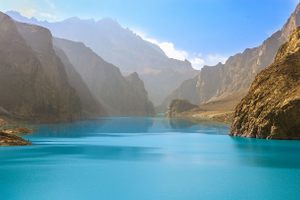About
In a world of commercial space flight and supersonic jet flight, it can be easy to forget just how hard it can be to traverse certain parts of this planet.
But those living in the Gilgit-Baltistan region of Northern Pakistan were cut off from the rest of Pakistan until 1978 due to the mountainous terrain and lack of roads. You could take a small airplane, but that was reserved for only the richest citizens.
For everyone else, the only way to travel was by walking across mountain passes to Rawalpindi. In 1978, the Karakoram Highway was completed and the region was connected, but inter-region travel remains as difficult as it was 100 years ago.
Regular aspects of travel through this region include the rickety cable and plank bridges that cross Northern Pakistan's mountain streams and rivers. Among these is the Hussaini Hanging Bridge, crossing Borit Lake in the Upper Hunza. This rope bridge is both long and poorly maintained. Many planks are missing, and strong winds shake the bridge as you cross it. As of now, there is only one suspension bridge connecting the Hussaini Village with Zarabad (located across the Hunza River)
Despite its dangerous looks, however, the Hussaini is is a relatively safe bridge and has become one of the most sought-after tourist attractions, with hikers testing their nerves as they carefully work their way across.
After being washed away in a 2011 monsoon, the bridge has been completely reconstructed and it now relies on steel cables and solid wooden boards. Facilities next to the bridge offer ziplining and sky-cycling.
Related Tags
Know Before You Go
Ticket price for foreign visitors is 1,000 pakistan rupees
There is a small Juice Outlet that serves the fresh cherries juice and it is a must try.
Locals from the village have also setup small stalls of dry fruit which are cultivated by them.
Community Contributors
Added By
Published
May 7, 2010
Updated
July 17, 2024

























